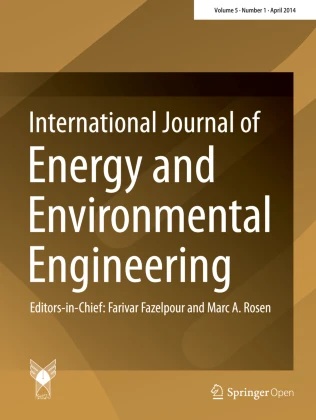Maximum power point tracking of a standalone photovoltaic system using electromagnetic field optimization algorithm
- College of Engineering and Applied Sciences, American University of Kuwait, Salmiya, KW
- Department of Electrical Engineering, College of Engineering and Petroleum, Kuwait University, Al-Shadadiya, KW

Published in Issue 2023-03-01
How to Cite
Imdoukh, A., & Zribi, M. (2023). Maximum power point tracking of a standalone photovoltaic system using electromagnetic field optimization algorithm. International Journal of Energy and Environmental Engineering, 14(4 (December 2023). https://doi.org/10.1007/s40095-023-00559-z
Abstract
Abstract There are non-stop efforts being put into enhancing the performance of the available maximum power point tracking methods and proposing new tracking methods. In this paper, a novel maximum power point tracking method based on a physics-inspired metaheuristic algorithm called Electromagnetic Field Optimization algorithm is proposed. The methodology of applying the Electromagnetic Field Optimization method on the maximum power point tracking problem is explained. The proposed method is applied to control the duty cycle of a DC–DC converter in a standalone photovoltaic system. The performance of the proposed method is evaluated against the Cuckoo Search Algorithm method, the Particle Swarm Optimization method, the Perturb and Observe method, and the Incremental Conductance method. A simulation test using MATLAB/Simulink software was conducted for varied sun irradiance levels under fixed temperature and load conditions. An experimental test was also conducted under fixed load and fixed weather conditions. The proposed method achieved tracking efficiencies of 100% and 80.14% in the simulation and experimental tests, accordingly. The superiority of the proposed method over the other applied metaheuristic-based methods is highlighted as the proposed method achieved short tracking times, no steady-state oscillations, and no duty cycle oscillations in both tests. The easiness of tuning the proposed method’s parameters is also an advantage of it.Keywords
- Photovoltaic system,
- MPPT,
- SEPIC,
- EFO,
- P&O,
- CSA
References
- IEA: Global energy review: CO2 emissions in 2021. International Energy Agency (2021).
- https://iea.blob.core.windows.net/assets/c3086240-732b-4f6a-89d7-db01be018f5e/GlobalEnergyReviewCO2Emissionsin2021.pdf
- Arthouros, Z: Renewables 2021: global status report. REN21 (2021).
- https://www.ren21.net/wp-content/uploads/2019/05/GSR2021_Full_Report.pdf
- Bendib et al. (2015) A survey of the most used MPPT methods: conventional and advanced algorithms applied for photovoltaic systems 45(1) (pp. 637-648) https://doi.org/10.1016/j.rser.2015.02.009
- De Brito et al. (2012) Evaluation of the main MPPT techniques for photovoltaic applications 60(3) (pp. 1156-1167) https://doi.org/10.1109/TIE.2012.2198036
- Sarvi and Azadian (2021) A comprehensive review and classified comparison of MPPT algorithms in PV systems 13(2) (pp. 281-320) https://doi.org/10.1007/s12667-021-00427-x
- Bollipo et al. (2020) Critical review on PV MPPT techniques: classical, intelligent and optimisation 14(9) (pp. 1433-1452) https://doi.org/10.1049/iet-rpg.2019.1163
- Karami et al. (2017) General review and classification of different MPPT techniques (pp. 1-18) https://doi.org/10.1016/j.rser.2016.09.132
- Mao et al. (2020) Classification and summarization of solar photovoltaic MPPT techniques: a review based on traditional and intelligent control strategies (pp. 1312-1327) https://doi.org/10.1016/j.egyr.2020.05.013
- Motahhir et al. (2020) The most used MPPT algorithms: review and the suitable low-cost embedded board for each algorithm (pp. 1-17) https://doi.org/10.1016/j.jclepro.2019.118983
- Pal and Mukherjee (2020) Metaheuristic based comparative MPPT methods for photovoltaic technology under partial shading condition https://doi.org/10.1016/j.energy.2020.118592
- Rezk and Eltamaly (2015) A comprehensive comparison of different MPPT techniques for photovoltaic systems (pp. 1-11) https://doi.org/10.1016/j.solener.2014.11.010
- Rezk et al. (2017) A comparison of different global MPPT techniques based on meta-heuristic algorithms for photovoltaic system subjected to partial shading conditions (pp. 377-386) https://doi.org/10.1016/j.rser.2017.02.051
- Verma et al. (2016) Maximum power point tracking (MPPT) techniques: recapitulation in solar photovoltaic systems (pp. 1018-1034) https://doi.org/10.1016/j.rser.2015.10.068
- Saka and Dogan (2012) Recent developments in metaheuristic algorithms: a review 5(4) (pp. 31-78) https://doi.org/10.4203/ctr.5.2
- Abedinpourshotorban et al. (2016) Electromagnetic field optimization: a physics-inspired metaheuristic optimization algorithm (pp. 8-22) https://doi.org/10.1016/j.swevo.2015.07.002
- Ahmed and Salam (2015) An improved perturb and observe (P&O) maximum power point tracking (MPPT) algorithm for higher efficiency (pp. 97-108) https://doi.org/10.1016/j.apenergy.2015.04.006
- Alik and Jusoh (2018) An enhanced P&O checking algorithm MPPT for high tracking efficiency of partially shaded PV module (pp. 570-580) https://doi.org/10.1016/j.solener.2017.12.050
- Loukriz et al. (2016) Simulation and experimental design of a new advanced variable step size Incremental Conductance MPPT algorithm for PV systems (pp. 30-38) https://doi.org/10.1016/j.isatra.2015.08.006
- Nugraha and Lian (2019) A novel MPPT method based on cuckoo search algorithm and golden section search algorithm for partially shaded PV system 42(3) (pp. 173-182) https://doi.org/10.1109/CJECE.2019.2914723
- Alshareef et al. (2019) Accelerated particle swarm optimization for photovoltaic maximum power point tracking under partial shading conditions 12(4) (pp. 1-18) https://doi.org/10.3390/en12040623
- Mirza et al. (2019) Novel MPPT techniques for photovoltaic systems under uniform irradiance and partial shading (pp. 628-648) https://doi.org/10.1016/j.solener.2019.04.034
- Killi and Samanta (2015) Modified perturb and observe MPPT algorithm for drift avoidance in photovoltaic systems 62(9) (pp. 5549-5559) https://doi.org/10.1109/TIE.2015.2407854

 10.1007/s40095-023-00559-z
10.1007/s40095-023-00559-z











